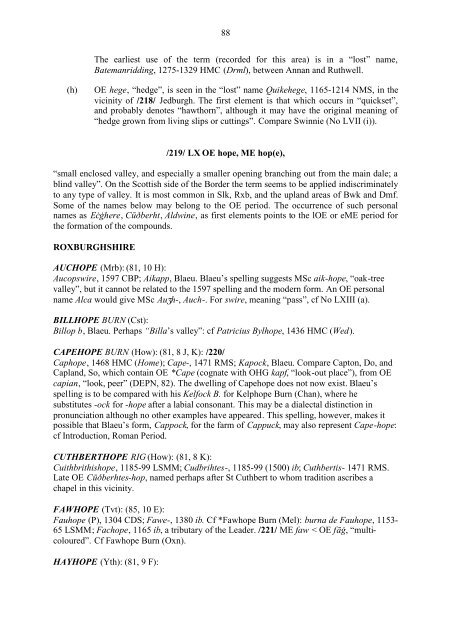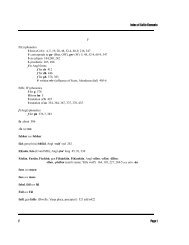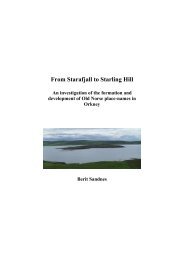May Williamson: The Non-Celtic Place-Names of the Scottish Border ...
May Williamson: The Non-Celtic Place-Names of the Scottish Border ...
May Williamson: The Non-Celtic Place-Names of the Scottish Border ...
Create successful ePaper yourself
Turn your PDF publications into a flip-book with our unique Google optimized e-Paper software.
88<br />
<strong>The</strong> earliest use <strong>of</strong> <strong>the</strong> term (recorded for this area) is in a “lost” name,<br />
Batemanridding, 1275-1329 HMC (Drml), between Annan and Ruthwell.<br />
(h)<br />
OE hege, “hedge”, is seen in <strong>the</strong> “lost” name Quikehege, 1165-1214 NMS, in <strong>the</strong><br />
vicinity <strong>of</strong> /218/ Jedburgh. <strong>The</strong> first element is that which occurs in “quickset”,<br />
and probably denotes “hawthorn”, although it may have <strong>the</strong> original meaning <strong>of</strong><br />
“hedge grown from living slips or cuttings”. Compare Swinnie (No LVII (i)).<br />
/219/ LX OE hope, ME hop(e),<br />
“small enclosed valley, and especially a smaller opening branching out from <strong>the</strong> main dale; a<br />
blind valley”. On <strong>the</strong> <strong>Scottish</strong> side <strong>of</strong> <strong>the</strong> <strong>Border</strong> <strong>the</strong> term seems to be applied indiscriminately<br />
to any type <strong>of</strong> valley. It is most common in Slk, Rxb, and <strong>the</strong> upland areas <strong>of</strong> Bwk and Dmf.<br />
Some <strong>of</strong> <strong>the</strong> names below may belong to <strong>the</strong> OE period. <strong>The</strong> occurrence <strong>of</strong> such personal<br />
names as Eċġhere, Cūðberht, Aldwine, as first elements points to <strong>the</strong> lOE or eME period for<br />
<strong>the</strong> formation <strong>of</strong> <strong>the</strong> compounds.<br />
ROXBURGHSHIRE<br />
AUCHOPE (Mrb): (81, 10 H):<br />
Aucopswire, 1597 CBP; Aikapp, Blaeu. Blaeu’s spelling suggests MSc aik-hope, “oak-tree<br />
valley”, but it cannot be related to <strong>the</strong> 1597 spelling and <strong>the</strong> modern form. An OE personal<br />
name Alca would give MSc AuZh-, Auch-. For swire, meaning “pass”, cf No LXIII (a).<br />
BILLHOPE BURN (Cst):<br />
Billop b, Blaeu. Perhaps “Billa’s valley”: cf Patricius Bylhope, 1436 HMC (Wed).<br />
CAPEHOPE BURN (How): (81, 8 J, K): /220/<br />
Caphope, 1468 HMC (Home); Cape-, 1471 RMS; Kapock, Blaeu. Compare Capton, Do, and<br />
Capland, So, which contain OE *Cape (cognate with OHG kapf, “look-out place”), from OE<br />
capian, “look, peer” (DEPN, 82). <strong>The</strong> dwelling <strong>of</strong> Capehope does not now exist. Blaeu’s<br />
spelling is to be compared with his Kelfock B. for Kelphope Burn (Chan), where he<br />
substitutes -ock for -hope after a labial consonant. This may be a dialectal distinction in<br />
pronunciation although no o<strong>the</strong>r examples have appeared. This spelling, however, makes it<br />
possible that Blaeu’s form, Cappock, for <strong>the</strong> farm <strong>of</strong> Cappuck, may also represent Cape-hope:<br />
cf Introduction, Roman Period.<br />
CUTHBERTHOPE RIG (How): (81, 8 K):<br />
Cuithbrithishope, 1185-99 LSMM; Cudbrihtes-, 1185-99 (1500) ib; Cuthbertis- 1471 RMS.<br />
Late OE Cūðberhtes-hop, named perhaps after St Cuthbert to whom tradition ascribes a<br />
chapel in this vicinity.<br />
FAWHOPE (Tvt): (85, 10 E):<br />
Fauhope (P), 1304 CDS; Fawe-, 1380 ib. Cf *Fawhope Burn (Mel): burna de Fauhope, 1153-<br />
65 LSMM; Fachope, 1165 ib, a tributary <strong>of</strong> <strong>the</strong> Leader. /221/ ME faw < OE fāġ, “multicoloured”.<br />
Cf Fawhope Burn (Oxn).<br />
HAYHOPE (Yth): (81, 9 F):




